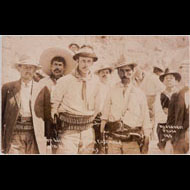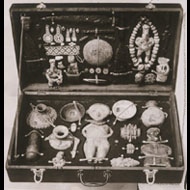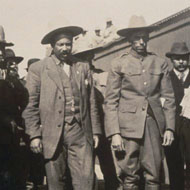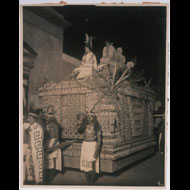Photographers
The photographers included in this section range from well-known to little-known, and their work has been documented to varying degrees. Many images in this site are attributed to unknown photographers, and other images are signed with only initials or surnames. Photographers represented here for whom there exists very little information include: P. Flores Perez, C. C. Harris, D. W. Hoffman, Hoyas, Jorschke, L. Lebert, Eduardo Melhado, L. R. Pimental, and Villegas.
 |
|
Jim A. Alexander (1863–1926) operated a photography studio in El Paso, Texas
and photographed the revolution in northern Mexico.
François Aubert (1829–1906) traveled to Mexico from France in the 1850s. In 1864 he bought Jules (Julio) Amiel's Mexico City photography studio.
For the next few years he photographed Emperor Maximilian and his court, and
documented the French presence in Mexico. He also produced images of Mexico
City and environs and made a series of Mexican tipos or "types."
Aubert left Mexico shortly after the execution of Maximilian in 1867 and opened
a photography practice in Algeria.
Lorenzo Becerril (1837–1904) was born in Puebla, became a captain in the Eastern
Cavalry Forces, and fought against the French in the Battle of Puebla, in 1862.
He operated a photographic portrait studio in Puebla from 1870–1915. In 1873
he began producing a series of Mexican tipos.
Grant J. Bobier (1892–1972) was born in Iowa to French immigrant parents.
He was a bricklayer and farmer by trade. Bobier was vacationing in the border
area of San Benito, Texas, and Matamoros, Mexico when constitutionalist General
Lucio Blanco captured the federal garrison at Matamoros and occupied the town.
Bobier took and collected photographs as these and other events of the Mexican
Revolution unfolded across the U.S.-Mexican border.
Hugo Brehme (1882–1954) was a German photographer who worked in colonial Africa
and Dresden before going to Veracruz, Mexico, around 1908. In 1910 he moved
to Mexico City, where he established a studio, quickly becoming one of the most
popular photographers in the city. Brehme joined Casasola's Agencia Fotográfica
Mexicana in 1911. He documented key events of the Mexican Revolution, notably
the Decena Trágica of 1913, Emiliano Zapata's activities in Morelos,
and the 1914 U.S. intervention in Veracruz. In addition to his documentary
work during the revolution, Brehme also sought opportunities to capture the
sublime in his photographs of Mexico. Many of these romanticized, idyllic images
were published in his album México pintoresco (1923), a classic of Mexican
pictorial photography.
 |
|
Abel Briquet (dates unknown), a photography teacher at the French military
academy of Saint-Cyr and a Parisian studio photographer, arrived in Mexico in
1883 to photograph Mexican ports for the shipping firm Compagnie Maritime Transatlantique.
He opened a studio in Mexico City in 1885 and began to produce a large body
of work on a variety of subjects—from landscape, flora and fauna, and tipos to
views of Pre-Columbian, colonial, and modern buildings and monuments. He created
a number of commemorative albums for the Porfirian government that documented
modernization projects and public works, and also published photographic series
with titles such as Vistas Mexicanas and Tipos Mexicanos. Briquet is considered
to have been the first modern commercial photographer in Mexico.
Agustín Victor Casasola (1874–1938) worked for various Mexico City newspapers
beginning in 1894, first as a typographer and then as a sports reporter. In
1900 he acquired his first camera and began illustrating his articles. Casasola
was the unofficial photographer of Porfirio Díaz and his government
until it fell in 1911, at which point he became one of the principal chroniclers
of the Mexican Revolution. He established the Agencia Fotográfica Mexicana
in 1911, bringing together photographers such as Manuel Rámos, Hugo
Brehme, and Eduardo Melhado in an organization that could be competitive with
international picture agencies. From then on, Casasola's role became
not just that of a photographer and reporter, but also that of a photo-archivist.
Casasola rescued the El imparcial photographic archive upon the newspaper's
closing in 1917, and these images, along with others he had long created and
collected, were the impetus for his Album historico gráfico of 1921.
Claude-Joseph-Désiré Charnay (1828–1915) first traveled to Mexico
in 1857 on a photographic mission for the French Ministry of Public Education.
His photographs of Mexico City, taken while staying in the city in 1858, were
compiled in Álbum fotográfico mexicano (1860), published by Julio
Michaud. From Mexico City Charnay traveled to Mitla in the state of Oaxaca
and throughout the Yucatán peninsula before returning to France at the
end of 1860. Cités et ruines américaines (1863), Charnay's
album of 49 photographs with text by Viollet-le-Duc, was the French
public's first introduction to ancient Mexico. Between 1880 and 1886
Charnay made three more trips to Mexico, recording archaeological sites as well
as making ethnographic portraits and views of cities and villages. Publications
from Charnay's later trips include Les anciennes villes du nouveau monde (1885).
André-Adolphe-Eugène Disdéri (1819–1889) was a Parisian
photographer whose studios flourished under the patronage of European nobility,
aristocracy, and celebrities during the Second Empire. He invented the carte-de-visite,
an inexpensive mounted albumen print the size of a calling card, in 1854. The
collecting and trading of cartes-de-visite of famous personalities became wildly
popular during the 1860s and 1870s.
Alice (Dixon) Le Plongeon (1851–1910) See Augustus Le Plongeon
Louis Falconnet (dates unknown) was an officer in the French army stationed
in Mexico during the French intervention. He assembled an album from the documentation
and materials he created and collected while in Mexico, including watercolor
drawings, cloth samples, wood engravings, hand-written letters and carte-de-visite
portraits.
Antonio Garduño (dates unknown) was a Mexico City photographer. His
early work included documentation of the events of the Mexican Revolution that
took place in and around Mexico City. He became a significant figure in the
Mexican photographic scene, organizing photographic competitions for venues
such as the Seville World's Fair (1928), and contributing photography
and Italian translations to magazines such as Helios. He became editor of that
periodical in 1931.
 |
|
Auguste Génin (1862–1931) an industrialist and founder of an explosives company,
was also a well known poet, Mexican cultural historian, and collector. Although
Génin was born in Mexico, his father was French and his mother Belgian. He
studied in France, returning to Mexico in 1879. Between 1882 and 1885, he traveled
widely across the country, representing French commercial interests. While
working in his family's business, he was commissioned by the French government
to carry out archaeological and ethnographic studies that led to a series of
studies for the Trocadero Museum in Paris in 1893, 1895, and 1922.
H. J. Gutierrez (dates unknown) was one of a number of photographers working
in Mexico City whose documentation of the Mexican Revolution was quickly disseminated
to the populace in the form of postcards.
Walter E. Hadsell (ca. 1880–?) was an American photographer. He graduated
from the University of Arizona Mining Department in 1904, and around 1909 worked
as an operator in the Henry Beuhman Photography Studio in Tuscon, Arizona,
where the staff were described as "photographers and dealers in Arizona
views, moldings, and picture frames." He was in Mexico throughout the
1910s and 1920s and in 1914 documented the U.S. intervention in Veracruz.
Walter H. Horne (1883–1921) was an American entrepreneur who arrived in El
Paso in 1910 and stayed until his death 11 years later. Although he apparently
had little previous interest in photography, Horne saw the financial potential
of the photographic postcard, opened a studio, and began covering the revolution
in northern Mexico, the Mexican-American border conflict, and the daily life
of the soldiers stationed along the border. By 1914 he had established himself
as a prominent wholesaler of war scene postcards, distributing large quantities
of his cards throughout the United States.
William Henry Jackson (1843–1942) was an American photographer known for his
pioneering photographs of the American frontier. He worked from
1870 to 1878 as an official photographer
of the United States Geological and Geographical Survey of Territories, taking photographs of western North America. He was the first
to photograph the territory of Yellowstone, and his photos were instrumental
in establishing it as a national park. In 1883 Jackson was commissioned by
the Mexican Central Railway to photograph its inaugural train ride between
Ciudad Juárez and Mexico City, and to produce a series of publicity photographs
for the company. On a return trip to Mexico in 1884 he made photographs of
a variety of typical Mexican subjects. In 1885 he published several albums
of documentary views of Mexico and Colorado. Jackson owned various photographic
studios through which he sold his work to the general public. In 1897 he became
part owner of the Detroit Publishing Company, which published and distributed
the new work he continued to produce, as well as copies of his earlier work.
Guillermo (Wilhelm) Kahlo (1872–1941), father of the artist Frida Kahlo, was born in Baden-Baden, Germany. He immigrated to Mexico in 1891 at the age of 19, and
married the daughter of Antonio Calderón, the Oaxacan studio photographer
to whom he had been apprenticed. Kahlo opened his own studio in Mexico City
in 1901, garnering commissions from the periodicals El mundo ilustrado and
Semanario ilustrado. From 1904 onward he received numerous government commissions
to inventory Mexico's architectural monuments. In 1910 he completed a
photographic inventory of Spanish colonial church architecture in Mexico. Almost
200 of these images were later published in Dr. Atl's Iglesias de México.
 |
|
Augustus Le Plongeon (1826–1908) was a photographer, medical doctor, and archaeologist.
After graduating from the École polytechnique in Paris, he traveled
to Chile and California. While on a trip to England in 1851, Le Plongeon learned
William Henry Fox Talbot's paper negative process. Upon his return to
California he opened a photographic studio in San Francisco. In the early 1860s
Le Plongeon moved to Lima, Peru, where he practiced medicine and photography
and became interested in Peruvian archaeology. In 1870 he traveled to England
where he met Alice Dixon (1851–1910). The couple returned to North America, where they married, and devoted
their lives' work to excavating, documenting, and describing the Mayan
ruins and culture of the Yucatan peninsula. They spent the better part of a
decade (1873–1883) exploring Yucatan and Central America, excavating at Chichén
Itzá and Uxmal. In the field they worked closely together recording
their findings on stereographic glass plate negatives. The Le Plongeons settled
in New York and spent the latter part of their careers writing and lecturing
on both ancient and contemporary Mayan culture. Publications by Augustus include
Vestiges of the Mayas (1881), and Sacred Mysteries among the Mayas and Quiches (1886), and, by Alice, Here and There in Yucatan (1886), and Queen Moo's
Talisman (1902).
Juan de Dios Machain (dates unknown) left an extensive archive of postmortem
portraits taken in Ameca, Jalisco, from the late 1800s to 1930, that document
rural funerary practices in Mexico.
Teobert Maler (1842–1914 or 1917) was a German architect who adopted Austrian
citizenship. He arrived in Mexico in 1865 as a cadet in the First Company of
Pioneer Volunteers fighting in support of the French Intervention, and subsequently
joined the Imperial Mexican Army. In 1867 after the fall of the empire, he
began photographing Mexican villages and indigenous peoples. He visited Mitla
in 1875 and Palenque in 1877 before returning to Europe where he lectured on
Mexico for several years. Maler returned to Mexico in 1884 to undertake a systematic
photographic documentation of Mayan archaeological sites in the states of Yucatan,
Campeche, and Quintana Roo. From 1892 to 1905 Maler worked with the Peabody Museum's
expeditions in Mayan territory, particularly in Chiapas. His work at the various
sites was published as part of the Memoirs of the Peabody Museum of
Archaeology and Ethnology series.
Lord Alfred Percival Maudslay (1850–1931), an English scientist with a background
in geology, botany, and zoology, made seven trips to Central America between
1881 and 1894, including expeditions to Copan, Quirigua, Tikal, Palenque, Yaxchilan,
and Chichén Itzá. Probably the most scientific Mayan archaeologist
of the 19th century, Maudslay's photographic documentation and
plaster casts of inscriptions were instrumental in deciphering Mayan hieroglyphics.
His monumental study Archaeology, part of the Biología Centrali-Americana series (1889–1902),
includes photographs of Mayan ruins, flora and fauna, and scenes of the daily
lives of indigenous peoples.
 |
|
R. M. Metcalfe (dates unknown) was an American photographer who had a studio in El Paso, Texas, and was one of many photojournalists to record the Mexican-American border conflict and the revolution in northern Mexico.
Félix Miret (dates unknown) was one of a number of photographers whose
documentation of the Mexican Revolution was quickly disseminated to the populace
in the form of postcards.
Cal Osbon (dates unknown) was an American photographer who documented the Mexican-American border conflict, particularly in the area around Douglas, Arizona.
Osuna (dates unknown) photographed the Decena Trágica of 1913. Over
300 images from those ten days are signed Osuna, most of which depict scenes
in and around the Felicista stronghold at the Ciudadela.
Agustín Péraire (dates unknown) ran a photography studio in
Mexico City during the second half of the 19th century. He is known to
have pirated photographs of the French Intervention taken by François
Aubert.
André-Toussaint Petitjean (dates unknown) was captain of the first
artillery regiment of the Corps Expeditionnaire Français. While on his
tour of duty in Mexico (ca.1864–1866), he documented his experiences on the
campaign trail via visual and written materials. He developed an interest in
experimental photographic processes, taking the Mexican countryside as his
subject.
Prevot (dates unknown) was a French photographer who operated a photography
studio in Mexico City in the second half of the 19th century.
Manuel Ramos (1874–1945) was an early press photographer who worked
mostly in Mexico City. In 1903 his photograph of the gored bull fighter Segurita,
published in El Imparcial with his signature below the image, became the first
signed photograph to appear in the Mexican press. Rámos joined Casasola's
Agencia Fotográfica Mexicana and made extensive coverage of the Decena
Trágica of 1913. Later, Rámos turned to architecture and landscapes
as his principal subjects. His book Mexico moderno was published in 1937.
 |
|
F. Gómez Rul (dates unknown) was one of the principal photographers
working in Mérida at the turn of the 20th century. The Guerra family,
who created a prominent archive of Yucatán photography, collected his
work.
Homer Scott (dates unknown) was an American photographer who had a studio
in El Paso, Texas, and was one of many photojournalists to record the Mexican-American
border conflict and the revolution in northern Mexico. He established the Scott
Photo Company and also worked with the Mexican War Photo Postcard Company.
P.C. Schockey (dates unknown) was an American photographer active during the early 1900s in Harlingen, Texas. He documented the Mexican revolution along the Mexican-American
border, including the battle of Matamoros.
Henry N. Sweet (?–1933) was assistant to Edward Herbert Thompson, the American
Consul in Mérida. He was the photographer for Thompson's expeditions
to Uxmal, Kabah, Sayil, and Labná in 1888–1891, and Alfred Percival Maudslay's
exploration of Chichén Itzá in 1889.
Charles Betts Waite (1861–1929) was a California photographer who worked briefly in El Paso, Texas before moving to Mexico in 1896. Waite opened a studio
in Mexico City that remained in business until he left the country in 1913.
During that time he produced a large body of work ranging from documentation
of archaeological and scientific expeditions to contributions to periodicals
and tourist guides. He also received numerous commissions from businesses such
as the U.S.-owned Chiapas Rubber Company. The most prolific of the new type
of commercial photographer active during the last two decades of the Porfiriato,
Waite is best known for his tipos and views, which
were widely distributed as postcards.